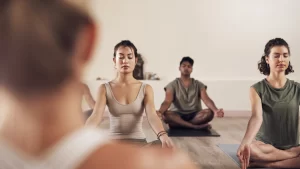The 8 Limbs of Yoga
4 min read
Practicing Yoga involves eight basic limbs. These limbs are Asana, Pranayama, Dharana, Samadhi, Bhakti, Raja, Kriya, and Mantra. Practicing yoga involves a combination of the various limbs to get the best results.
Asana
Using the eight limbs of yoga is a great way to achieve the highest state of awareness. However, you’ll want to make sure that you understand what each limb is all about and how they will help you achieve that state of awareness.
The first limb of the eight limbs is yama. This limb is about awareness of yourself. It involves making choices that are aligned with your highest self. It also involves moderation and self-study.
The second limb is niyama. These niyamas focus on cleanliness, self-surrender, self-study, and contentment. They are designed to help you develop a healthy lifestyle.
The third limb of the eight limbs of yoga is asana. Asana is the physical postures that are used in yoga. These postures help prepare the mind and body for meditation. These poses also help increase concentration.
The fourth limb of the eight limbs of Yoga is prana. Prana is a Sanskrit term that means breath control. Practicing this limb of yoga will help you recognize the relationship between your breath and your mind. It also helps you control the subtle life force currents.
Pranayama
Practicing yoga requires dedication and consistency. As you continue your journey, you may find that the practice of yoga helps you achieve balance in your life. You will also gain knowledge that will guide you through your life.
Yoga is a philosophy that promotes physical and mental well-being. Yoga includes both physical postures and breathing techniques. The 8 limbs of yoga are a practical way to achieve a deep state of awareness.
The yamas are ethical principles that guide a yogi’s interactions with the world. These include self-discipline, cleanliness, austerity, self-surrender, and contentment.
The niyamas are the second limb of yoga. They are self-observance practices, which include self-study and contemplative moments. Niyamas are not about perfection, but about making choices in alignment with your highest self. They are also about self-control.
Pratyahara is the fifth limb of yoga. It is a conscious effort to withdraw one’s senses from external stimuli. This is done to prepare the mind for the next limb.
Dharana
Having a clear understanding of Dharana will help you in your practice. Dharana is a practice of concentration and meditation. It is one of the eight limbs of yoga.
The limbs of yoga, as described by Patanjali in the yoga sutras, are designed to help you develop a focus of mind. You must practice the limbs of yoga to reach a state of pure awareness. This state is called samadhi, and is sometimes referred to as union with the divine. It is a peaceful state of bliss that will allow you to experience profound wisdom and insight.
When practicing dharana, you must focus all of your attention on one object. This will slow the thinking process and help you become more concentrated. You can focus on something within you, or on an object in front of you. You can use a mantra, such as OM, during your meditation practice.
Dharana is a state of focus and concentration that is achieved by following your breath. This allows you to unclench your mind and body, making it easier to focus on the moment.
Samadhi
Often translated as meditation, samadhi is the state of deep absorption and supreme presence. It is a blissful and peaceful state that is not disturbed by emotions, thoughts, or sensations.
To attain samadhi, one must first purify his mind. This can be accomplished through ethical and physical practices. It is also important to learn how to stay focused on the present moment. This is best accomplished by practicing sensory withdrawal. The fifth limb of yoga, pratyahara, is a practice that is designed to help one focus on the inner world.
Pratyahara can be achieved by imagining a bright white light during meditation. It can also be practiced by repeating a mantra. In order to attain samadhi, a yogi must learn to practice complete and total focus.
The first limb of yoga is yama, which teaches a yogi to live a moral and ethical life. It also teaches a yogi how to interact with the world and the internal self.
The second limb of yoga is niyama, which teaches a yogi how to practice self-observance and self-surrender. It includes contentment, cleanliness, and self-study.








